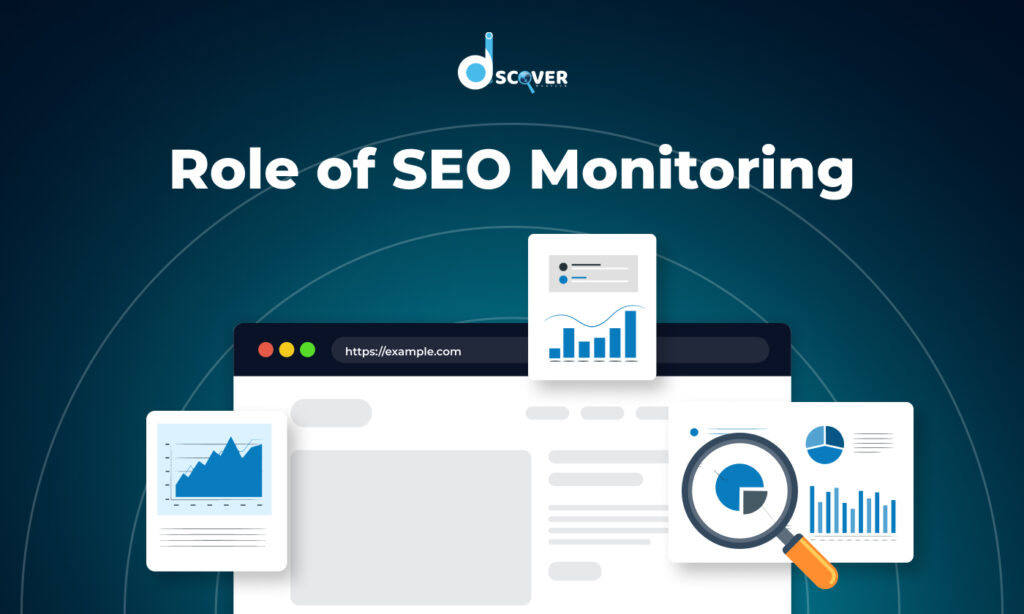
At Discover WebTech, we believe that continuous improvement is the key to sustained digital success. That’s why SEO monitoring is at the heart of everything we do for our clients and projects. It’s not just about tracking keywords or fixing issues—it’s a mindset of staying proactive, data-driven, and agile in a landscape that changes faster than ever.
In this blog, we’ll walk you through how SEO monitoring works, why it’s critical for long-term SEO success, what our team monitors, and how we use automation to make the process smarter—not harder.
1. What Is SEO Monitoring?
According to a SEO expert, SEO monitoring is the ongoing process of tracking important SEO metrics to monitor—like keyword rankings, organic traffic, conversions, and site health—and making adjustments based on the data.
At Discover WebTech, we don’t believe in “set it and forget it.” Instead, our team members use SEO monitoring to create a continuous loop of observation, analysis, and optimization. This ensures our strategies stay effective no matter how algorithms evolve or user behaviors shift.
2. Why SEO Monitoring Matters for Long-Term SEO Success
Here’s why we never skip SEO monitoring—and neither should you:
a. Sustain and Improve Rankings
Our team regularly tracks keyword positions to see what’s gaining and what’s losing ground. If a key page drops, we jump in to refresh or restructure the content before it impacts traffic.
b. Catch Technical Errors Early
Broken links, crawl errors, or mobile usability issues can creep in quietly. With regular SEO monitoring, we spot them early—before Google does.
c. Adapt to Algorithm Updates
Google rolls out hundreds of updates a year. When rankings or impressions suddenly shift, our team investigates fast to determine if an algorithm update is the cause.
d. Keep Content Fresh and Competitive
Content that worked six months ago might not perform today. We use SEO monitoring to identify content decay and update or repurpose blogs, landing pages, and even service descriptions.
e. Prove ROI with Real Numbers
One of the biggest advantages of SEO monitoring is clarity. We tie organic performance directly to leads, conversions, and ROI—so you can see exactly how SEO helps your business grow.
3. Core Elements We Monitor at Discover WebTech
Our SEO performance tracking process is comprehensive. Here’s what our team keeps a close eye on as part of essential SEO metrics to monitor:
- Keyword Rankings
We track a wide range of keywords—from core terms to long-tail queries—to ensure visibility across all buyer stages. - Organic Traffic & Impressions
We monitor both traffic and impressions to see not only how many people visit, but how often we’re showing up on search. - Conversions & Conversion Rate
Our job isn’t done when traffic increases. We analyze how well that traffic converts and optimize accordingly. - Backlink Profile
We track new backlinks, lost links, and potential spammy referrals. A healthy backlink profile is a big part of long-term SEO success. - Technical SEO & Core Web Vitals
Our developers monitor speed, interactivity, and layout shifts. Tools like Lighthouse and PageSpeed Insights help us stay in Google’s good graces. - Indexation & Crawl Errors
Using Google Search Console, we track which pages are indexed and catch any crawl blocks or errors. - User Behavior Metrics
High bounce rates or short dwell time signal problems. We dig into these numbers using GA4 and Hotjar to improve user experience and intent match.
4. How We Handle SEO Performance Tracking Effectively
We’ve developed a step-by-step system for SEO performance tracking:
Step 1: Align Metrics with Business Goals
We sit with clients to understand what success looks like—leads, sales, or authority. Then we define the SEO metrics to monitor that matter.
Step 2: Select the Right Tools
From Ahrefs and SEMrush to GA4 and Search Console, we tailor our stack to each project’s needs.
Step 3: Set Benchmarks and Review Cycles
Our team reviews performance weekly and runs detailed audits monthly or quarterly, depending on the client’s growth stage.
Step 4: Create Smart Alerts and Reports
We automate alerts for keyword drops, broken links, and major performance shifts. Weekly reports are sent with analysis and next steps.
Step 5: Take Action
When something changes—whether it’s a traffic dip or ranking gain—we don’t just report it. We investigate and take action fast.
Step 6: Iterate and Improve
Our team treats SEO monitoring like a flywheel—each round of feedback makes the next round stronger.
5. How We Use Automated SEO Monitoring
Automated SEO monitoring helps us save time, avoid human error, and scale efforts across multiple sites. Here’s how we implement it:
- Saving Time
Our dashboards automatically pull data from GA4, Search Console, and Ahrefs, giving us daily snapshots for action. - Ensuring Consistency
With scheduled crawls and scans, we ensure no metric or issue slips through the cracks. - Managing at Scale
Whether we manage one website or fifty, automated SEO monitoring keeps our process efficient and results-focused. - Accuracy and Precision
No more manual errors. Our scripts and alerts are clean, fast, and accurate.
That said, automated SEO monitoring is just a tool. Human interpretation still drives our strategic recommendations and implementation.
6. Common SEO Monitoring Mistakes We Help Clients Avoid
Here are the most common SEO monitoring mistakes businesses make—and how we solve them:
- Tracking Rankings Without Context
We always relate rankings back to traffic and conversions to get the complete picture. - Ignoring User Behavior
Our team dives deep into bounce rate, time on page, and scroll depth to ensure content matches intent. - Keeping Outdated Benchmarks
As the website grows, benchmarks evolve. We update targets based on new goals and industry changes. - Using Tools That Are No Longer Relevant
We continuously upgrade our toolkit to ensure we’re capturing the most important data—like Core Web Vitals and mobile experience.
7. Our Favorite Tools for SEO Monitoring
Here are the essential tools for SEO monitoring we rely on at Discover WebTech:
- For Keyword Tracking
We use Google Search Console, Ahrefs, and SEMrush to track keyword positions and SERP features. - For Traffic and Behavior
GA4, Hotjar, and Crazy Egg help us understand user interaction beyond basic analytics. - For Backlinks
SEMrush, Ahrefs, and Moz Link Explorer provide deep insight into the quality and trends of backlinks. - For Technical Performance
Screaming Frog, Sitebulb, and Google PageSpeed Insights allow us to audit site health with a technical lens. - For Reporting & Alerts
With Looker Studio, we automate performance dashboards and alerts for smarter decision-making.
Conclusion
At Discover WebTech, SEO monitoring is not a task—it’s a culture. It empowers our team to stay agile, improve continually, and deliver real value to every client we serve.
From automated SEO monitoring to smart use of tools for SEO monitoring, we ensure that your website doesn’t just perform—it grows. By avoiding common SEO monitoring mistakes and focusing on the right SEO metrics to monitor, we help you achieve long-term SEO success in the truest sense.
Our latest blog on “Understanding BigQuery Data Types: A Beginner’s Guide”


